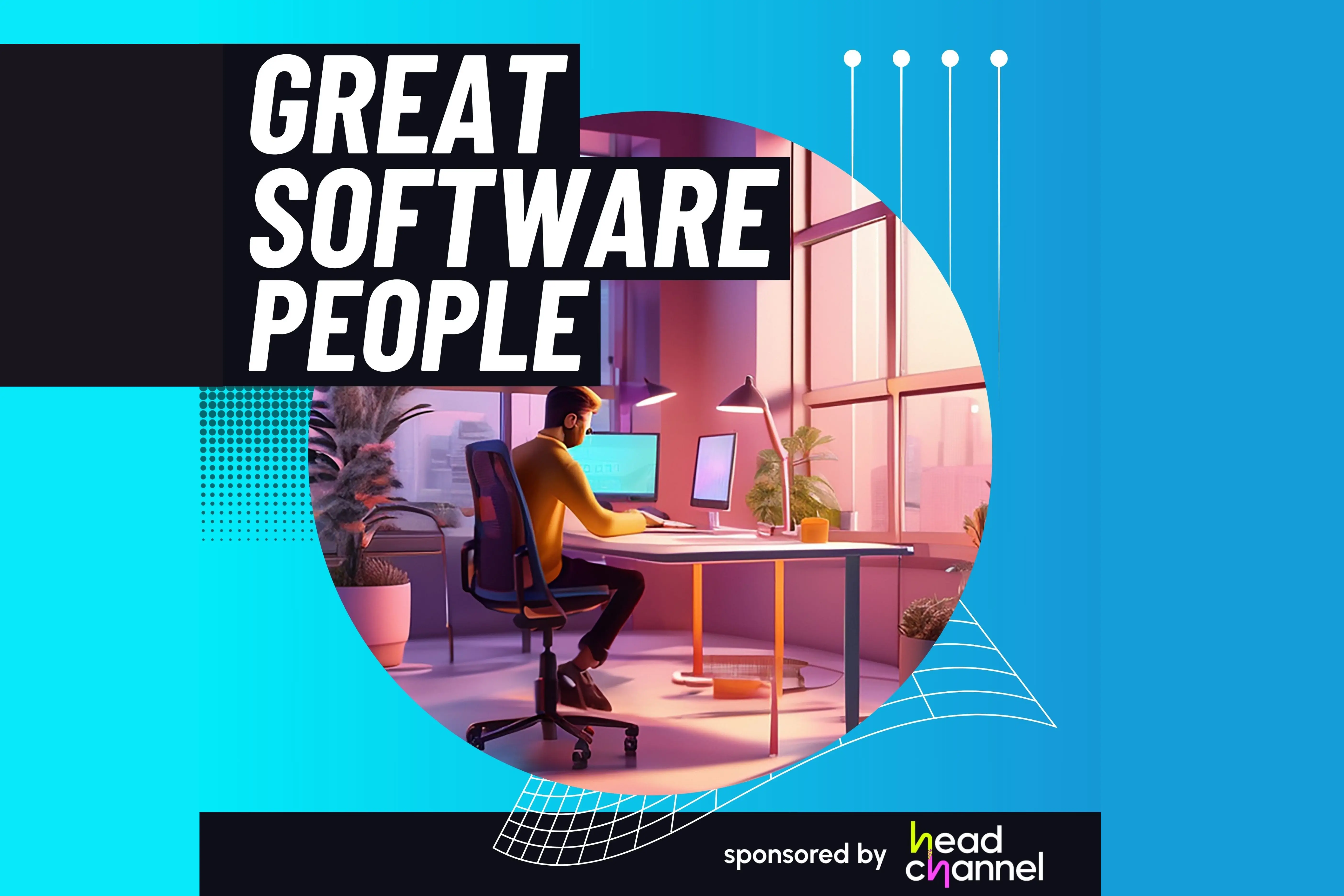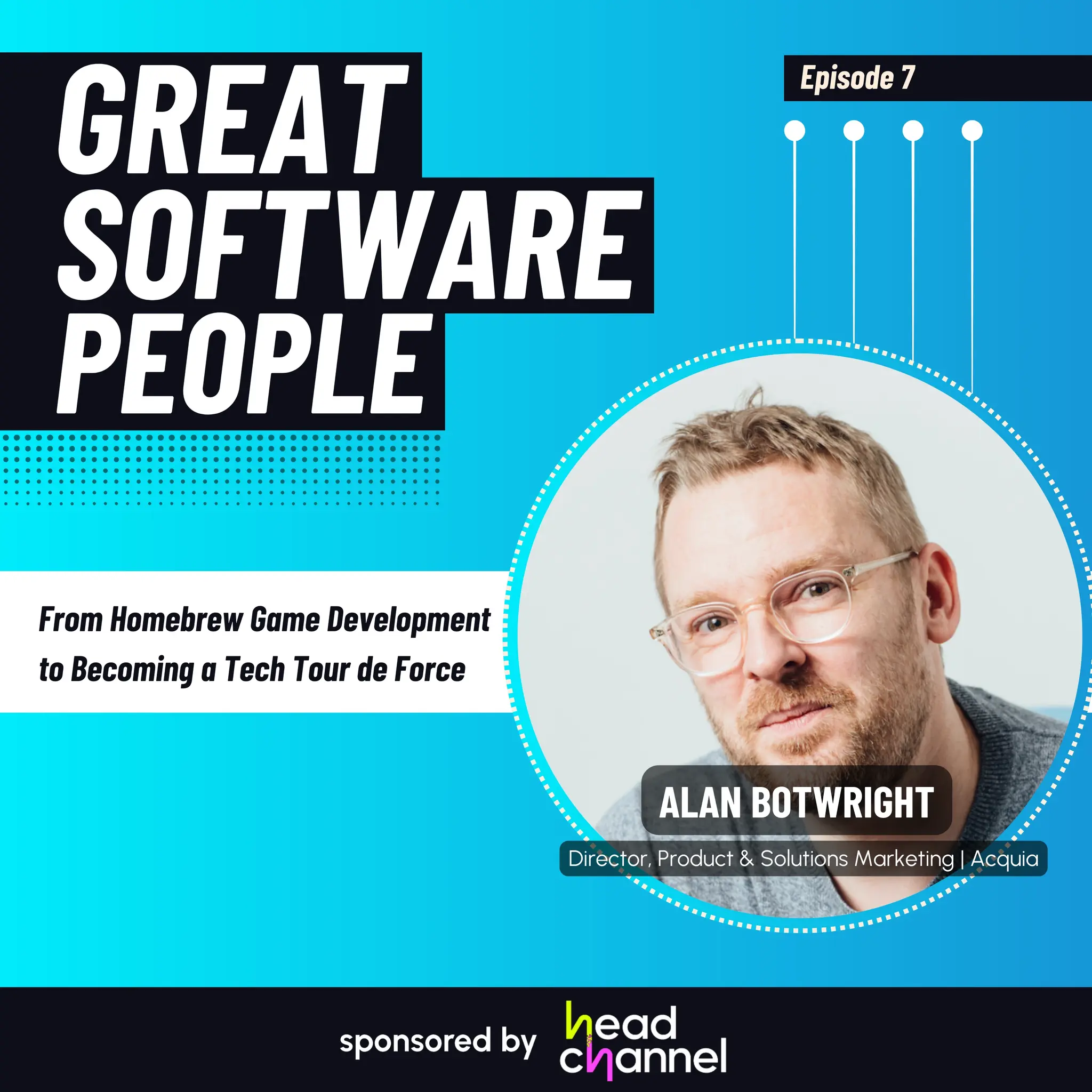
From Homebrew Game Development to Becoming a Tech Tour de Force with Director, Product & Solutions Marketing at Acquia, Alan Botwright - E7
As a budding teenager, Alan Botwright coded level design on the Commodore 64’s Judge Dredd game. Decades later, he’s carved out a career in software with huge global impact.
Alan’s story is packed with exciting anecdotes and unique insights alike - he joins us on Great Software People to share standout moments of innovation, his take on an AI-enabled future, and why ‘cool’ doesn’t always cut it.
This episode covers:
-
Alan’s start in the industry, and early experiments with the Commodore in particular
-
Writing hugely successful games software as a teenager
-
Standout moments of innovation
-
How many large organisations are lost in the sea of new technologies

Episode highlights
“I was writing game software as a teenager, and the biggest release was Judge Dredd on the Commodore 64. The games industry wasn’t what it is now, it was quite home brew.” - 6:25 - Alan Botwright
“There were some great leaders there, and I learned a hell of a lot about ways of framing value in what we were doing. It was a real education - I really appreciate being given enough scope in someone’s successful agency just to go off and do this.” - 17:00 - Alan Botwright
“I was trying to move into the product space a bit more. So a few experimental applications that I was working on; one was similar to a SkySports, BBC Sports thing where you could arrange competitions with other schools.” - 23:25 - Alan Botwright
“It’s not just about building the coolest thing - it’s about what kind of change management programmes go with it and enabling stakeholders.” - 31:00 - Alan Botwright
“Post-pandemic, customers have gone back in terms of investing in technologies because they’ve just bought loads of stuff and not really understood it.” - 40:00 - Alan Botwright
LISTEN HERE:
[00:00:13]
Rich: Welcome to another episode of Great Software People. With me today, I have Alan Botwright, Director of Product and Solutions Marketing at Acquia. Hi, Alan, and welcome!
Alan: Thanks, Rich. Good to be here.
Rich: I don’t know if you’ve listened to the podcast before, but we always start with the same question. How did your journey begin? Did you wake up one day as a kid and decide, “This is what I want to do”?
[00:00:46]
Alan: I definitely didn’t have a plan! I’m a child of the late 1980s home computer boom, and I started out making demos as part of what’s now called the demo scene. At the time, it was just a bunch of kids with home computers messing around and learning together. It all started with the Commodore 64—my first love in computing. I still have it!
Rich: Ah, the bread bin design, right?
Alan: That’s the one—a design classic! A friend and I were part of the school computer club, which doesn’t sound very glamorous, but it’s where I got my start. We started experimenting with things like cracking games to add infinite lives and creating intros. Then we discovered Compunet, which was a dial-in peer-to-peer network. This was the late ’80s, so we were racking up massive phone bills just to download files, which often crashed halfway through. My parents weren’t thrilled.
[00:02:39]
Rich: So this was like the pre-internet internet, right?
Alan: Exactly. It was slow, expensive, and unreliable, but it was our lifeline to the wider demo scene. This was a community of developers pushing computers to do things they were never designed to do—like creating demos with music and visuals.
Rich: Music back then wasn’t just playing an audio file, was it? You were programming the sound chip directly?
Alan: That’s right. The Commodore 64 had a famous sound chip called SID. It was basically an analog synthesizer you controlled through code. It was incredibly powerful but also complex to program. We had to get into assembler language to unlock the real potential of the Commodore. We were essentially reverse-engineering commercial software, figuring out how music players worked, how sprites moved, and how scrolling was implemented. Then we used those tricks in our demos.
[00:05:00]
Alan: Eventually, a friend and I approached a few games companies with our demo discs, which were like our portfolios. One company in East London asked us to create a level for a game. I was only 15 or 16 at the time, still in school, and suddenly I had my first paid contract.
Rich: What was the game?
Alan: It was called Rumble. The concept was simple: two people jump out of a plane with one parachute, and they fight over it before hitting the ground.
[00:06:00]
Alan: After that, my mum found an ad in the paper: “Would you like to convert arcade games to home computers?” I applied and got the job. Before I knew it, I was working on games like Judge Dredd for the Commodore 64, which was published by Virgin.
Rich: That’s a big title!
Alan: It was a huge leap for me, going from bedroom hacking to a commercial games studio. But back then, the games industry was still very homebrew. We were small teams—usually one developer and one artist per platform.
[00:08:40]
Rich: So how long did these games take to make?
Alan: Judge Dredd took about 18 months. I worked on four games in total over four years. It was a dream job at first, but eventually, I found the process of finishing games tedious. I was more interested in the innovation—pushing the hardware to its limits. Once that was done, I’d lose interest.
[00:09:33]
Rich: So what came next after you left game development?
Alan: I took a bit of a break and tried my hand at being a musician, which didn’t go far. But then I got drawn into the early days of the internet. It had the same allure as home computers—something new and full of possibilities.
[00:11:00]
Rich: Did you start as a web developer?
Alan: Yeah, I was working in London agencies, experimenting with early web technologies. At first, it was static websites, then include files, and eventually databases. I had no formal training in databases, so I learned through trial and error—lots of mistakes!
[00:12:09]
Rich: At some point, you decided to start your own company, right?
Alan: Yes, a friend and I created a platform that was sort of like an early version of Confluence. One of our clients wanted a digital archive of their marketing materials, going back 30 years. They handed us zip disks and other ancient storage media, and we built a system to catalog everything. It was all hand-coded in PHP, very innovative for its time.
[00:15:28]
Rich: After that, you ended up back at an agency as their Development Director?
Alan: That’s right. The agency wanted to create a credible digital arm, and I helped them punch above their weight. We worked on some massive projects, often blagging our way in, but we delivered!
Rich: Sounds like you learned a lot about selling the vision of innovation?
Alan: Absolutely. I became more strategic, focusing on solving business problems with technology. We worked on everything from early social media to interactive simulations for financial institutions.
[00:22:40]
Rich: After that, you went back to running your own company?
Alan: Yes, I’d effectively been running a company within the agency, so I felt ready. I specialized in Drupal, working on big projects like launching TV channels. I also dabbled in product development, building tools for sports competitions and brand sentiment analysis.
[00:26:18]
Rich: And then you joined Acquia, where you’ve been for nearly 10 years. How did that happen?
Alan: I deployed a high-profile project on Acquia’s platform, and they reached out. At first, I thought I’d just build a partnership with them, but they convinced me to join.
[00:28:00]
Rich: You started in technical account management, but it sounds like your love for innovation carried through?
Alan: Definitely. I moved into pre-sales, working on large enterprise solutions. It was all about connecting technology to business value and building trust with clients.
[00:33:03]
Rich: Do you still get to work on greenfield projects and push the boundaries?
Alan: I do. I work with clients to explore what’s next, often using capability models to map their strengths and weaknesses. It’s about creating next-generation experiences and tying them to business outcomes.
[00:38:13]
Rich: What does the future hold for you and the technology you’re working with?
Alan: AI is the big focus now, both generative tools like ChatGPT and machine learning for automation. But it’s not just about adopting the latest tech—it’s about using it responsibly to solve real problems.
[00:42:19]
Rich: Alan, this has been an incredible journey through your career. Thank you so much for sharing your story on Great Software People.
Alan: Thanks, Rich. It’s been a pleasure.

Contact us.
If you need a partner in software development, we're here to help you.
We will respond to your enquiry immediately.